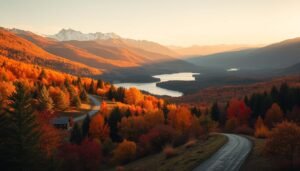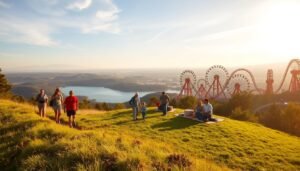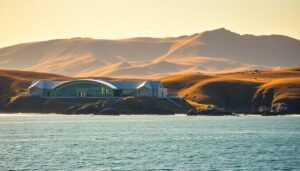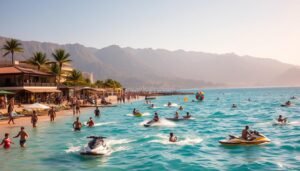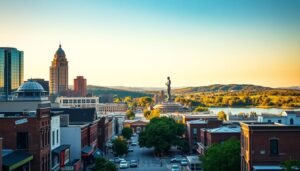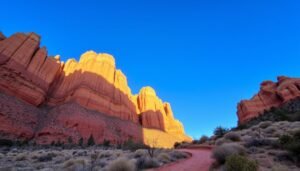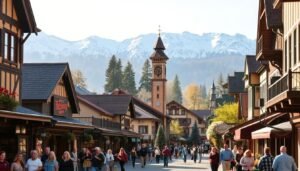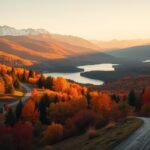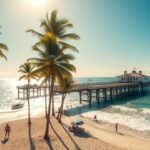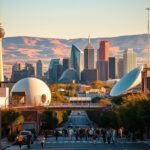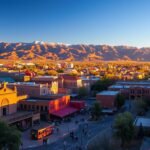Surprising fact: more than 11 million people visit the city region each year, and many plan their trip around just a handful of highlights.
I wrote this guide after a week of wandering neon riverwalks and quiet temple gardens. I loved Dotonbori’s famous Glico sign, Shinsekai’s retro arcades and Tsutenkaku, the seasonal blooms at Osaka Castle, and the massive tanks at Kaiyukan with whale sharks.
I built my itinerary to balance food, culture, and skyline views. I stayed near Namba and Umeda for easy hotel access and used IC cards for quick travel. I booked an observatory and aquarium in advance, while I left other hours free for wandering.
This short guide will show you the best attractions, help you plan time efficiently, and point out when a pass or reservation saves you time and money. Read on and pick the one highlights that fit your trip and pace.
Key Takeaways
- Mix headline sites and quiet spots: balance Dotonbori with temple grounds.
- Stay near Namba or Umeda: both make reaching attractions easy.
- Book timed tickets for popular observatories and the aquarium.
- Consider the Osaka Amazing Pass to save on entry fees and transit.
- Plan around seasons—cherry blossom and fall color windows change the vibe.
How I Planned My Time in the City
I built a simple rhythm for my visit so travel felt smooth and flexible. I made a basic itinerary that split mornings for major sights and afternoons for food and shopping. This kept my days focused and left room for serendipity.
For a short trip osaka, two full days cover central highlights. With four nights I added a day trip to Nara or Kyoto and still relaxed. I timed travel: Shinkansen from Tokyo (~2.5 hours), local trains from Kyoto (~1h20m), and direct trains from KIX to Namba or Umeda under an hour.
I favored trains for long hops and walked within compact neighborhoods. When transfers dragged, a taxi saved precious time. I booked select tickets and a pass ahead to skip lines and see more.
- Cluster visits: pair Shinsekai with Shitenno-ji and Tennoji Park.
- Order tip: do castle and aquarium on separate daylight days for best views.
- Evening flexibility: keep nights open for photos and snacks.
For a quick planning checklist and sample day breakdown, see my short trip osaka highlights guide for easy reference.
Things to do in Osaka
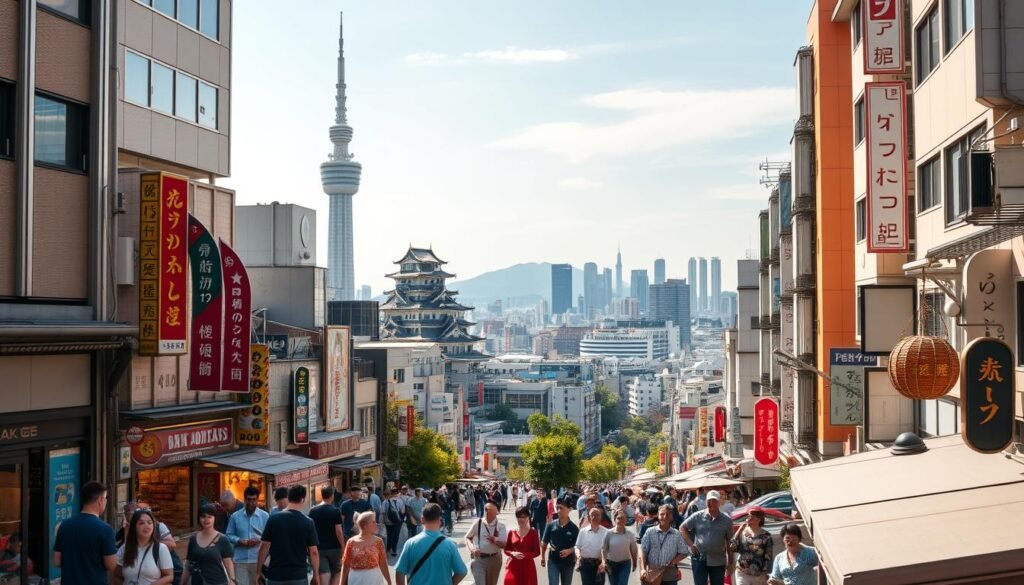
I grouped attractions into walkable clusters so transit felt effortless and fast. That made my days efficient and left room for food stops and late-night wandering.
My quick-hit list for first-time visitors
I split must-see spots by area to keep walking short and transfers simple. I paired Dotonbori with Namba and Shinsaibashi for evening lights and shopping, and linked Shinsekai with Tennoji and Shitenno-ji for a retro daytime loop.
- Dotonbori: Glico sign, Ebisubashi Bridge, Tombori Riverwalk, Hozen-ji Yokocho.
- Namba / Shinsaibashi: Shinsaibashi-Suji, Doguyasuji, Kuromon Ichiba market.
- Bay area: Kaiyukan aquarium and Tempozan for a calm maritime break.
- Skylines: Umeda Sky Building or HARUKAS 300 — pick one for sunset views.
- Castle & temples: Osaka Castle Park and nearby temple grounds.
How I balance food, culture, and night lights in one trip
I mixed street grazing with sit-down meals. Breakfasts and market snacks kept me moving. Evenings were for a relaxed restaurant or kushikatsu in Shinsekai.
When rain hit, I swapped an outdoor walk for a museum or observatory. Trains linked neighborhoods fast, so squeezing a day trip to Nara or Himeji felt natural and tidy.
- Quick checklist: Dotonbori, Namba market, Shinsekai, Osaka Castle, Kaiyukan, one observatory, and a short day trip.
Dive into Dotonbori’s Neon Nights and Riverwalk Vibes
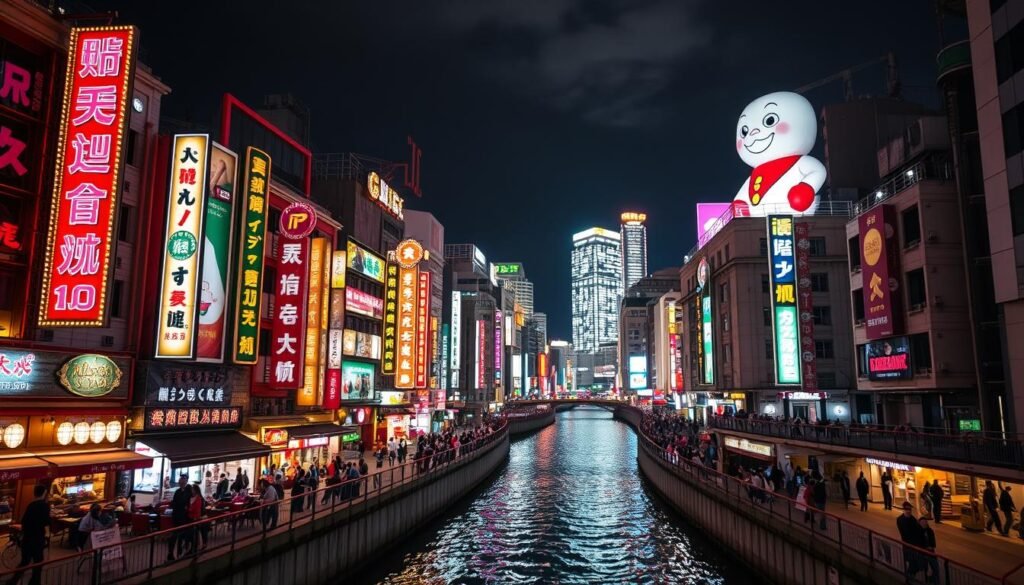
Nightfall paints Dotonbori in electric colors that change with every ripple of the river. I timed my visits for blue hour because the reflections on the Tombori Riverwalk are unbeatable for photos. Glico’s running man and Ebisubashi Bridge became my steady reference points as I wandered.
Glico Sign, Ebisubashi Bridge, and Tombori Riverwalk
I used Ebisubashi as my photo angle at night; the bridge frames the sign and the water gives great reflections. Walk the river slowly and pick a low railing spot for long exposures.
Hozen-ji Temple and Hozenji Yokocho’s hidden restaurants
When crowds press in, I duck into Hozenji Yokocho. The lantern-lit alleys offer a quieter atmosphere and cozy restaurants that feel decades old. I collected a goshuin stamp at the temple before heading back out.You can learn things-to-do-in-puerto-rico
Street eats: takoyaki and okonomiyaki spots I loved
I compared takoyaki textures at several stands and saved room for okonomiyaki at Chibo and a tiny neighborhood restaurant near the temple. I paid cash at counters and kept my bag close in busy streets.
“Arrive 30–45 minutes after sunset for the best lights without the densest crowds.”
- Follow a loop: Glico → riverwalk → Ebisubashi → Hozenji Yokocho.
- Pivot indoors if rain hits; many restaurants accept cash only.
Namba and Shinsaibashi: Shopping Streets, Back Alleys, and Late-Night Energy
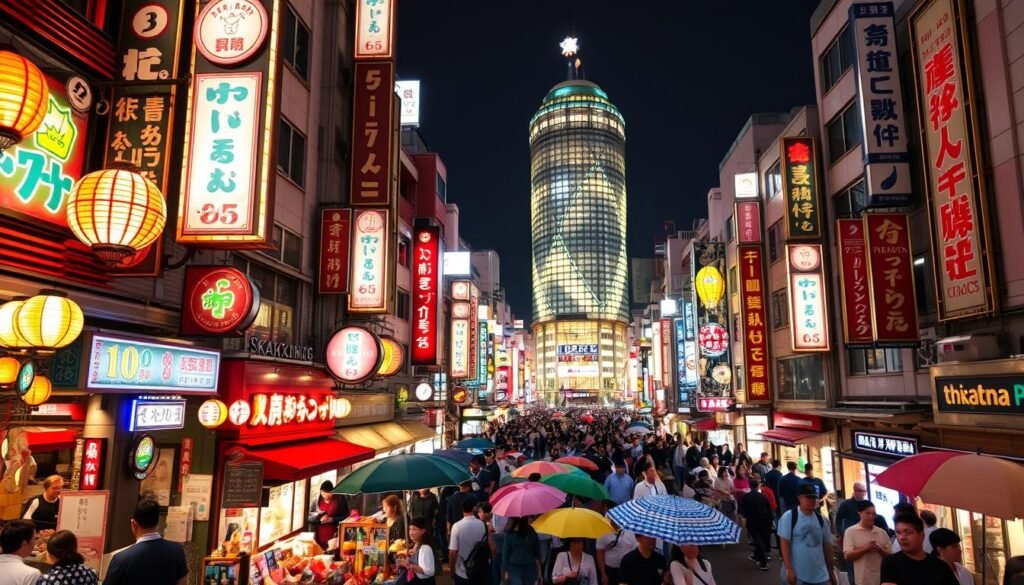
I paced the long Shinsaibashi arcade end-to-end, then ducked into side streets for quieter finds. The contrast is what makes this area fun: flagship stores and lifestyle retailers sit beside tiny craft shops.
Shinsaibashi-Suji is a covered arcade with major stores and bright displays. I map my walk so I visit big-name stores first, then pop into smaller shops without feeling overwhelmed.You can learn things-to-do-in-fredericksburg-tx
Hands, Kuromon, and Kitchen Streets
I always stop at Hands Shinsaibashi for quirky household items and practical travel gear. Then I head to Kuromon Ichiba market in the morning for fresh seafood skewers before the rush.
Sennichimae Doguyasuji is my must-stop for knives and restaurant supplies. If you love cooking, the stores here are a treasure trove of bento boxes and specialty tools.
- I tuck into low-key cafes when I need a break from shopping flow.
- I sometimes explore a back alley a block off the main arcade for calmer places and better prices.
- I fit a quick visit to namba yasaka between runs to balance retail therapy with culture.
“Go early at Kuromon for the best picks and less crowding.”
| Spot | Best time | Why I like it |
|---|---|---|
| Shinsaibashi-Suji | Late morning | Flagship stores and easy arcade walk |
| Kuromon Ichiba | Early morning | Fresh seafood and snacks before crowds |
| Sennichimae Doguyasuji | Afternoon | Kitchenware, knives, and specialty tools |
| Namba side streets | Evening | Restaurants buzz and locals mingle |
- Stash purchases at lockers near stations and carry some cash for small stores.
- Sort tax-free receipts before you leave the area to save time.
- Use arcade entrances and station exits as my favorite location markers to stay oriented.
Temple Time: Shitenno-ji, Hozen-ji, and Sumiyoshi Taisha

I found quiet pockets of history among the city’s busiest streets, and the temple precincts offered a calm reset.
Shitenno-ji’s historic grounds and tranquil garden
Shitenno-ji dates back to 593, founded by Prince Shōtoku. The outer grounds are free, so I wandered the approach before paying for the central precincts.
I paired this stop with Tennoji Park for a relaxed half-day. Getting there early made the grounds feel especially serene.
Inside the paid area I lingered in the garden for about 30–45 minutes. The paths and ponds let me slow down without rushing the visit.
Sumiyoshi Taisha’s Sorihashi Bridge and peaceful precincts
Sumiyoshi Taisha felt gentle and quiet on a weekday. The arched Sorihashi Bridge makes a great photo spot; I framed the shrine with the bridge’s curve for a calm composition.
I found a few tucked corners for a quiet sit, far from the busier parts of the city. The precinct rewarded slow walking and light reflection shots.You can learn things-to-do-in-madrid
Hozen-ji’s mossy charm and goshuin stops
Hozen-ji sits in a Dotonbori back alley and reads like a pause between meals. I like to plan a short contemplative stop there after grabbing a snack.
Goshuin stamps are available at most of these shrines and temples. Bring small bills and a goshuincho if you collect them.
- Pairing tip: cluster Shitenno-ji with Tennoji Park for a calm half-day and fewer transfers.
- Timing: mornings are best for quieter grounds and cleaner photos.
- Modesty: dress modestly, speak softly, and step back when services happen.
- Snacks: plan a nearby bite so you keep energy up without breaking the flow.
“I scheduled temple time mid-morning; the contrast with late-night neon felt intentional and restorative.”
- Allow 1.5–2 hours for Shitenno-ji plus the garden.
- Give Sumiyoshi Taisha 45–60 minutes for photos and quiet walks.
- Keep Hozen-ji as a short contemplative spot between meals.
These temples show a softer side of the city and gave me a slower rhythm that balanced the bright, busy neighborhoods.
Namba Yasaka Jinja: The Lion-Head Shrine I’ll Never Forget

I walked up the narrow street and then froze—an enormous lion face filled the small urban clearing. The lion-head stage feels playful and powerful, a dramatic focal point tucked inside a busy neighborhood.
The shrine honors Amaterasu and Susanoo, and local lore says the open mouth wards off evil and brings luck. I felt that folklore in the moment; the design reads like a guardian watching over the area.
I found it least crowded mid-morning on a weekday and stayed about 20–30 minutes. I shot the full face by stepping back along the approach and using a low angle to capture the curve without a wide lens.
Practical notes: goshuin stamps are available at the office. During busier times expect a short line and bring small bills for the book and stamp fee.
It’s an easy detour from central Namba—walk a few blocks north and you’re there. I often pair the stop with a nearby café or a quick noodle lunch to make it a relaxed outing.
“Give a little space when people pray; the shrine feels alive during small ceremonies.”
Weather changes the mood here: bright midday visits feel bold, while rain makes the lion look cinematic. I’d prioritize this spot on a flexible day, or save it when I wanted a calm, short visit away from the busiest routes.
Osaka Castle and Park: Seasonal Views and Quiet Temple Grounds
![]()
I planned a slow loop that caught plum blooms, summer green, autumn reds, and the gentle winter lights without rushing. The park around the castle is free, so I often started here early to enjoy quiet paths and the Japanese Garden reflection angle.You can learn things-to-do-in-hilton-head
Walking the castle grounds and adjacent park each season
Spring brought sakura and bright crowds, while autumn showed fiery foliage along wide avenues. Winter offered calm paths and occasional illuminations that made short visits feel special.
I mapped a simple loop that hit my favorite viewpoints, including the pond reflection. I paused under trees for snacks and shade, and I wandered toward nearby temple areas when I wanted a quieter moment.
When it’s worth going inside the museum
The museum carries an entry fee but gives a top-deck view that frames the city and the castle tower. I paid for the museum when I wanted panoramic views and historical exhibits; otherwise the grounds offer plenty without cost.
- I budgeted 30–45 minutes for a park-only visit and 1.5–2 hours if I climbed the museum and deck.
- There is a small paid cart service for mobility needs between gates; it saved my legs on longer loops.
- I bought timed tickets online when available to skip lines and used early mornings to beat crowds.
“Plan castle time earlier in the day, then move indoors if the weather shifts or crowds rise.”
Retro Shinsekai and Tsutenkaku: Old-School Osaka After Dark
![]()
I watched neon signs wake up over narrow alleys and felt the neighborhood change its rhythm after dark. The sudden pop of color and humming storefronts gives the area a lively pulse that draws both visitors and locals.
Kushikatsu is the signature bite here. I picked counter seats when I wanted quick chat and hot skewers. For a slower crawl, I wandered Jan-Jan Yokocho and tried a few alleyway spots so I could taste more plates across restaurants.
Kushikatsu choices and counter culture
At counters the pace is conversational and fast. Alley stalls offer room to graze and photograph plates. I carried small bills and waited at peak times—lines form, but turnover is steady.
Tsutenkaku by day versus night
By day the tower feels mild and a little nostalgic. By night the observation deck and its neon bulbs make the neighborhood glow. I timed my visit near sunset so I could shoot both light stages.
“Keep your camera ready: Billiken statues pop up in unexpected corners and make for fun snapshots.”
- I paired Shinsekai with Tennoji for an easy afternoon-to-evening route.
- I recommend a light dinner crawl across two or three small spots rather than one heavy meal.
- Bring cash, expect short lines, and pick counter seating when you want lively chat.
| Spot | Best time | Why I like it |
|---|---|---|
| Jan-Jan Yokocho | Evening | Classic food alley with many kushikatsu choices |
| Tsutenkaku Observatory | Sunset | Great contrast between daylight views and neon below |
| Shinsekai counters | Late night | Friendly locals and quick plates at the bar |
- Photo angles: wide alley shots, low-angle Billiken frames, and rooftop glimpses toward the tower.
- Stay aware in crowds, keep valuables close, and enjoy the casual, easygoing vibe.
Best City Views: Umeda Sky Building and HARUKAS 300
![]()
I timed my observatory visits so one slot would capture daylight, sunset, and city lights in a single sweep. Both places reward careful timing: the Floating Garden Observatory gives dramatic escalators and wide panoramas, while HARUKAS 300 sits high atop Abeno Harukas at 300 m and delivers near-360-degree exposure.You can learn things-to-do-in-maui
Golden hour planning: I worked backward from sunset, booked an entry about 45–60 minutes before golden hour, and left buffer time for security and ticket queues. On busy weekends I added another 20 minutes.
Where I stood and what I packed
I like the outerwalk at Umeda for layered skyline shots and the HARUKAS viewing bench for low-angle city lights. Glass reflections can spoil a frame; I bring a lens cloth and look for angled panels or open-air sections.
- I pair an observatory visit with nearby shopping or dinner so the time feels seamless.
- Weather and haze sometimes shift plans; if visibility drops, I swap an observatory slot for a nearby museum or indoor market.
- Weekdays usually mean shorter lines; weekends can feel festive but require extra wait time.
Booking flow I used
- Check sunset time for the day of my visit.
- Pick an entry 45–60 minutes before that time and add 20 minutes on weekends.
- Reserve tickets online when available, then arrive 15 minutes early to clear security.
- Start at the outdoor or open sections, save inside glass walls for after sunset, and clean lenses as light fades.
“Booking golden hour lets you catch blue sky, warm sunset, and urban lights without rushing.”
Umeda Sky Building official site is where I compare times and reserve slots when I want the Floating Garden experience. If I had time for only one observatory, I picked HARUKAS 300 for sheer height or Umeda for dramatic architecture and nearby gardens—both deliver a genuine wow factor for a single-visit itinerary.
Osaka Aquarium Kaiyukan and Tempozan: A Day by the Bay

I spent an afternoon watching whale sharks glide while the harbor light shifted outside. Kaiyukan ranks among the world’s largest aquariums and its vertical path around the central tank reveals new angles as you descend.
I planned a half-day visit and moved slowly. I lingered longest at the central tank to watch the two whale sharks, then paused by the penguin and ringed seal pools for quiet observation.You can learn things-to-do-in-honolulu
Quick practical notes
- Book tickets online to skip the line and reduce stress at entry.
- Arrive mid-morning on weekdays for fewer school groups and calmer galleries.
- Tempozan Marketplace next door offers fast food courts and shops for a quick lunch and souvenirs.
I took short breaks on benches to avoid sensory overload and picked a harbor stroll after the aquarium for relaxed views. Families can follow clear signage; solo travelers will find easy pacing and plenty of photo spots.
“Plan a half-day here, then return to central neighborhoods for an easy evening—dinner near the castle makes a nice pairing.”
Parks and Green Spaces I Loved When I Needed a Breather
Midday park stops became my favorite way to breathe between crowded streets. I used short walks as a reset and found small gardens that changed my pace and mood.
Tennoji Park and Keitakuen Garden
Tennoji Park’s ponds and the compact Keitakuen Garden offered quiet benches and reflective water views. Nearby Horikoshi Jinja and Isshin-ji made it easy to add a brief temple visit without losing much time.
Nakanoshima, Utsubo Park, and a simple route
Nakanoshima sits between rivers with a rose garden that shifts by season; I planned a daytime stroll there for soft blooms and calm atmosphere.
Utsubo Park has walking paths and night lighting that makes evening walks feel safe and restorative. I usually stop at a nearby cafe for a quick drink and carry water and snacks on warmer days.
“I used parks as short mid-trip resets and returned to the night energy feeling refreshed.”
| Park | Best time | Why I liked it | Nearby add-on |
|---|---|---|---|
| Tennoji Park | Morning / mid-day | Ponds, quiet benches, Keitakuen Garden | Horikoshi Jinja, Isshin-ji |
| Nakanoshima Park | Day | Rose garden, river views by season | Museum walks and cafes |
| Utsubo Park | Evening / night | Rose beds, lit paths for safe strolls | Street cafes and bistros |
Quick tips: shoot during soft light for uncluttered views, pick shaded benches on warm days, and link two parks with a short train hop for one relaxed outing.
Eat Like a Local: My Favorite Restaurants and Food Tours
I tracked down old counters and busy stalls to learn how locals eat. Small plates, quick chats, and bright lanterns became my routine.
Takoyaki and okonomiyaki: where I’d go again
I compared takoyaki stands and sat at Houzenji Sanpei for a classic okonomiyaki. I watched sauces, batter texture, and chef speed to judge the difference.
For a reliable option, I used Chibo when time or comfort mattered. At each spot I ordered the simple versions first, then a sauced-up plate to compare.
Kawafuku Honten udon and wagyu yakiniku lunch sets
Kawafuku Honten felt like true home cooking. I stood at the counter, pointed at the display, and learned the menu that way.
For wagyu yakiniku I reserved a lunch set (prix-fixe roughly ¥3,000–¥4,500). Reservation is wise on peak nights. The set usually included multiple cuts, rice, and a small salad.
Why a Shinsekai food tour is worth it
A guided Shinsekai tasting moved me through Jan-Jan Yokocho and nearby izakaya. The guide explained local flavors and steered me past tourist traps.
I planned a night of grazing: start light, share plates, then finish with a richer dish. I carried cash for street stands and split portions to taste more.
- If lines are long: I had a backup restaurant a block away that often took reservations.
- How I asked for help: I smiled, pointed, and learned a few dish names — staff liked that and suggested seasonal specials.
“A guided crawl saved time and turned a hungry evening into a proper tasting tour.”
- Return picks: Kawafuku for udon, Houzenji Sanpei for okonomiyaki, Chibo for easy comfort.
- Pro tip: book wagyu lunches early and carry small bills for casual stands.
Tea, Cafes, and Coffee Roasters for a Chill Afternoon
On slow afternoons I hunted quiet cafes and tea rooms that felt like a soft pause between busy streets.
wad became my favorite for that exact reason. They offer a no-reservation tea service with hand-prepared brews and traditional sweets. Arriving at open often let me snag a seat and choose a cup that matched my mood.
The flow is simple: pick your cup, watch a careful pour, and enjoy sweets that tame a busy day. The slow rhythm and minimal chatter changed my pace in the best way.
Neel and a relaxed lunch
Neel served katsu sandwiches and matcha in a stylish, calm space. I treated it as a light lunch stop between shopping runs and found the design helped me recharge.
Bear Paw Cafe and my coffee rotation
Bear Paw Cafe (Kuma no Te) removes face-to-face service to support staff with social anxiety. I loved backing a place with that mission and the gentle, inclusive atmosphere it created.
My roaster rotation included Ourlog Coffee Roasters, LiLo Coffee Roasters, and Glitch Coffee. I ordered an espresso at Ourlog for a quick lift, a gentle filter at LiLo for reading, and a bold pour-over at Glitch when I needed a longer sit.
“A calm cup can reset the day and make the next route feel effortless.”
- I planned cafe breaks between long walks and shopping runs so energy stayed steady.
- Bookshop cafes were my fallback when I needed a quiet corner and a map spread out.
- I learned quick ordering: point, say a simple item name, and pay with a card or exact cash when menus ran minimal.
| Spot | What I ordered | Why I liked it |
|---|---|---|
| wad | Hand-prepared tea & sweets | Slow pace, no reservations, intimate cups |
| Neel | Katsu sandwich & matcha | Stylish lunch spot, great design for a break |
| Bear Paw Cafe | House coffee (no face service) | Supportive mission and calm service model |
| Tsutaya / OMNIBUS | Light coffee and reading corner | Bookshop cafes for planning and quiet time |
Starred locations on my map: wad, Neel, Bear Paw Cafe, Ourlog, LiLo, Glitch, Tsutaya Bookstore cafes, and CAFE & BAR OMNIBUS. Each sat near popular routes so I rarely backtracked.
America-mura and Nipponbashi DenDen Town: Fashion and Fandom
My favorite loop winds from bold murals to tiny figure shops, and it usually takes the better part of an afternoon.
I start in America-mura, an area of vintage racks, quirky cafes, and street art. I drift down side streets, ducking into small shops and snapping murals as I go. Triangle Park is my people-watching stop; I time visits for lively afternoons.
Then I cross toward Nipponbashi DenDen Town and follow Ota Road. I anchor at Super Potato Retrokan for retro games, and I check stores that sell figures, model kits, and doujinshi.
- I browse respectfully when places fill up and ask before photographing displays.
- I keep purchases organized in a small tote and use station lockers for heavy finds.
- I hunt pop-up exhibits and limited collabs online before I leave the neighborhood.
I pick a few snack cafes that match the creative vibe and circle back if something sells out fast. Below are reliable places that often yield fun discoveries:
- Triangle Park area
- Ota Road strip
- Hidden alleys around Amerikamura
“I let the side streets steer the day—some of my best finds appeared without a plan.”
Universal Studios Japan: A Full Day of Rides, Worlds, and Pop Culture
I planned my Universal Studios visit as a full-day mission: timed entries, a simple route, and a focus on the newest lands. Early arrival let me hit the must-rides before crowds swelled. I also grabbed a small locker near the gate so I could travel light and move faster between zones.You can learn things-to-do-in-lancaster-pa
How I’d tackle Super Nintendo World and Wizarding World
Super Nintendo World: I aimed for the earliest timed entry and headed straight for the marquee ride. I prioritized interactive attractions first, then used the mobile app to track wait times and return for the themed experiences that matched my energy.
Wizarding World: I split browsing and rides. I wandered the shops and snapped photos of detailed facades during lower-traffic windows, then queued for signature rides when the app showed shorter waits. The wand shops are worth a slow walk.
- I pivoted between zones based on live wait times and short snack breaks so I didn’t lose momentum.
- I ate outside peak lunch hours—quick refuels at cafes kept my queue time low.
- On weekends I picked three “must-do” attractions and used an express option for one of them.
“Timed tickets and a flexible route saved me hours; plan the headliners first and fill around them.”
| Plan element | My approach | Why it worked |
|---|---|---|
| Entry timing | Arrive before gate open + timed entry | Beat long mid-morning lines |
| Super Nintendo World | Priority ride first, then interactive play | New lands build long waits later in the day |
| Wizarding World | Photo & shop early, ride later | Better light for photos and shorter queues |
| Late-day plan | Catch final rides and evening ambiance | Lighting and mood improve; lines often drop |
Practical reminders: buy advance tickets, consider express passes if your time is tight, and reserve any required time slots. Next time I’d nudge one headliner earlier to squeeze in a final coaster—small shifts can add one more big ride without stress.things-to-do-in-sedona
Easy Day Trips from Osaka by Train
A handful of rail links made it easy for me to sample temples, castles, and forested shrines on quick trips. I picked each outing by how much walking I wanted and the weather forecast.
Nara: deer park, temples, and old streets
Nara sits about 45 minutes by rail. I started at the deer park, where the deer bow for crackers sold at stalls—watch your bag and enjoy slow photos.
I routed a short loop: Todai-ji, Nara-machi streets, then a snack at a small café away from the busiest temples. I left early to avoid the largest crowds.
Himeji Castle: the White Heron photo stop
Himeji is roughly 30 minutes by faster trains. I budgeted 2–3 hours for grounds, tower views, and the classic “White Heron” shot from the western moat.
Plan ticket time and walk the north gardens for a clean photo angle before crowd peaks.
Kyoto: temples, tea, and scenic streets
Kyoto fits a focused day: pick 2 temples, one tea house, and a scenic street like Ninenzaka. I used local trains and walked steadily to keep time manageable.
Katsuō-ji and Minoh: daruma and seasonal colors
Katsuō-ji sits near Minoh and feels like a forest retreat. I took the Midosuji Line to Minoh-Kayano, then a short bus or taxi for the daruma hill and maple paths.
It’s perfect for quieter views and a slower pace away from busier areas.
| Destination | Train time | Must-see | Local food |
|---|---|---|---|
| Nara | ~45 min | Deer Park, Todai-ji, Nara-machi | Try kakinoha-zushi or mochi snacks |
| Himeji | ~30 min | Himeji Castle, north gardens | Oden stalls and local sake |
| Kyoto | ~25–45 min | Selected temples, tea house, Ninenzaka | Matcha sweets and yudofu |
| Katsuō-ji / Minoh | ~40–60 min | Daruma hill, forest walks | Tempura and river-side snacks |
“Pick a trip that matches your walking mood, check train times, and plan a golden-hour return for city views.”
- Pack: comfy shoes, snacks, and an IC card for tap-and-go trains.
- Seat choice: grab window seats on longer hops for relaxed views.
- Backups: swap destinations by weather; Kyoto or a nearby park work well if rain comes.
When to Go, Where to Stay, and How I Get Around
Picking the right season shaped my pace and photos. Spring (March–April) brought sakura crowds and a festival buzz that made mornings busy but evenings magical. Late October–November offered brilliant fall color and crisp air that pushed me outdoors. Winter felt calm; I found quieter streets and lower hotel rates.
Cherry blossoms, fall foliage, and festival season
Spring is busiest; book hotels and observatory tickets early. I reserved three months ahead when I planned a cherry-blossom visit.
Autumn gives vivid leaves and steady daylight for walking. I timed one evening for illuminated paths and a less crowded castle view.
“Check festival dates—Tenjin Matsuri and local events can lift hotel prices and change transit flow.”
Staying in Namba vs. Umeda: my hotel picks
I favored Namba for nightlife and quick access to markets. My go-to hotels there were Cross Hotel Osaka and Swissotel Nankai Osaka for central comfort.
Umeda felt calmer and better for rail links. For a higher-end stay I chose Conrad Osaka or InterContinental Osaka; my mid-range pick was Zentis Osaka. For budget or business-style stays, Minn Umeda‑North and Hotel Royal Classic Osaka worked well.
JR, IC cards, and why I carry cash and an eSIM
I used JR lines and the metro together. An ICOCA card made that tap-and-go way easy and saved time on short hops. For day trips I anchored my itinerary near a major station so transfers stayed short.
I kept small bills for market stalls and tiny restaurants and topped up cash at 7‑Eleven ATMs. An eSIM or portable Wi‑Fi kept maps, reservations, and ticket apps working—essential when schedules tightened. Taxis made sense for late-night returns; expect short hops to cost modestly more than a train but save time when trains slowed or weather shifted.
| Need | My choice | Why I picked it |
|---|---|---|
| Best access for nightlife | Namba | Markets, restaurants, short walks after dark |
| Best rail hub | Umeda / Osaka Station | JR lines, easy day-trip links, calmer evenings |
| Card for transit | ICOCA (IC card) | Taps across JR and metro; speeds up travel |
| Connectivity | eSIM / portable Wi‑Fi | Maps, ticket apps, and real-time planning |
Packing and booking tips: bring a small adapter, layers for changing weather, and a lightweight day bag. Book peak-season hotels and any observatory slots at least 6–8 weeks ahead.
Conclusion
Conclusion
Use this final note as a quick playbook for shaping an itinerary that fits your pace and curiosity.
I focused this guide on clear choices: neon nights, quiet temple mornings, skyline views, family-friendly aquarium time, and easy day trips. Pick a few must-sees—like osaka castle—then leave gaps for small discoveries that make a trip feel yours.
Plan smart for busy attractions and save slow moments in gardens and park paths. Star key spots on your map, set rough time blocks, and let one unplanned alley or cafe reshape your day.
Osaka rewards curiosity. I hope my favorite memories—castle reflections, riverwalk nights, cozy alley dinners—help you plan yours.




